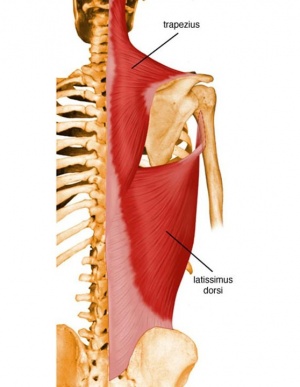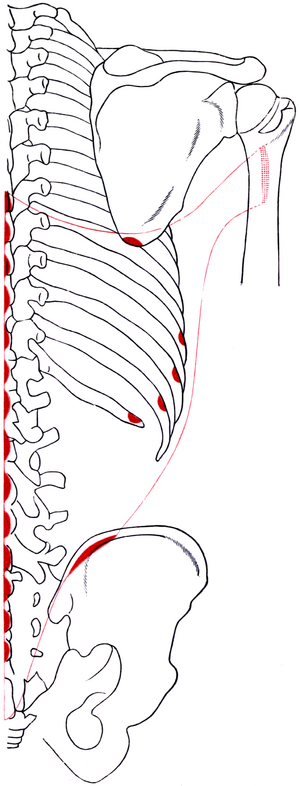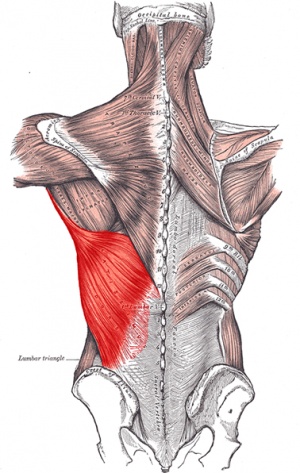Latissimus Dorsi Muscle: Difference between revisions
No edit summary |
No edit summary |
||
| Line 31: | Line 31: | ||
== Nerve and Blood Supply == | == Nerve and Blood Supply == | ||
Thoracodorsal nerve (C6 – C8)<ref name=":1">Calais-German B. Anatomy of Movement. Seattle: Eastland Press, 1993. </ref> from the posterior cord of the [[brachial plexus]], which enters the muscle on its deep surface.<ref name=":2">Palastanga N, Field D, Soames R. Anatomy and Human Movement: Structure and Function. 5th Ed. Edinburgh. Butterworth Heinemann. Elsevier. 2007.</ref> The skin covering the latissimus dorsi muscle is supplied by roots T4 to T12, inclusive by both ventral and dorsal rami, as well as the dorsal rami of L1 to L3.<ref name=":2" /><br> | Thoracodorsal [[Neurone|nerve]] (C6 – C8)<ref name=":1">Calais-German B. Anatomy of Movement. Seattle: Eastland Press, 1993. </ref> from the posterior cord of the [[brachial plexus]], which enters the muscle on its deep surface.<ref name=":2">Palastanga N, Field D, Soames R. Anatomy and Human Movement: Structure and Function. 5th Ed. Edinburgh. Butterworth Heinemann. Elsevier. 2007.</ref> The skin covering the latissimus dorsi muscle is supplied by roots T4 to T12, inclusive by both ventral and dorsal rami, as well as the dorsal rami of L1 to L3.<ref name=":2" /><br> | ||
== Action == | == Action == | ||
[[File:Latissimus-dorsi.jpg|alt=|right|frameless]]Latissimus dorsi works collaboratively with the teres major and pectoralis major to perform actions of the upper extremity. Together, these muscles will work to adduct, medially rotate and extend the arm at the glenohumeral joint. | [[File:Latissimus-dorsi.jpg|alt=|right|frameless]]Latissimus dorsi works collaboratively with the [[Teres Major|teres major]] and [[pectoralis major]] to perform actions of the upper extremity. Together, these muscles will work to adduct, medially rotate and extend the arm at the glenohumeral joint. | ||
Latissimus dorsi, along with teres major and the sternal head of pectoralis major, is also active in the extension of the humerus. | Latissimus dorsi, along with teres major and the sternal head of pectoralis major, is also active in the extension of the humerus. | ||
| Line 53: | Line 53: | ||
In activities such as walking with crutches, where the humerus becomes the fixed point when standing, latissimus dorsi has the ability to pull the trunk forwards relative to the arms. With this action there is also a lifting of the pelvis. In people with paralysis of the lower half of the body, the fact that latissimus dorsi attaches to the pelvis and the fact that it is still innervated, enables the person to produce movement of the pelvis and trunk. As a result of this, people wearing calipers and using crutches can achieve a modified gait by fixing the arms and hitching the hips by alternative contraction of each latissimus dorsi.<ref name=":2" /> | In activities such as walking with crutches, where the humerus becomes the fixed point when standing, latissimus dorsi has the ability to pull the trunk forwards relative to the arms. With this action there is also a lifting of the pelvis. In people with paralysis of the lower half of the body, the fact that latissimus dorsi attaches to the pelvis and the fact that it is still innervated, enables the person to produce movement of the pelvis and trunk. As a result of this, people wearing calipers and using crutches can achieve a modified gait by fixing the arms and hitching the hips by alternative contraction of each latissimus dorsi.<ref name=":2" /> | ||
== | == Physiotherapy == | ||
Latissimus dorsi | Latissimus dorsi may be implicated in patients with restrictions of motion of abduction, flexion and lateral rotation. Assessment of this muscle is crucial for patients with upper extremity pathology. Proper function and coordination with the teres major and pectoralis major muscles are essential for smooth and fluid movements of the upper extremity. For patients with low back pain, it is important to assess the length and flexibility of the latissimus dorsi due to the attachments on the spine and pelvis. A decrease in length or an increase in stiffness of this muscle can lead to alterations in movement patterns and/or postures which can exacerbate low back pain.<ref name=":4" /> | ||
=== Assessment === | === Assessment === | ||
| Line 75: | Line 75: | ||
{| width="100%" cellspacing="1" cellpadding="1" | {| width="100%" cellspacing="1" cellpadding="1" | ||
|- | |- | ||
| | | | ||
| {{#ev:youtube|vZ0ddF4v3Pg|412}} | | {{#ev:youtube|vZ0ddF4v3Pg|412}} | ||
|} | |} | ||
Revision as of 05:48, 31 December 2021
Original Editor - Ahmed Nassef
Top Contributors - Lucinda hampton, Wanda van Niekerk, Ahmed Nassef, Kim Jackson, Uchechukwu Chukwuemeka, Joao Costa, Wendy Snyders, Admin and George Prudden
Description[edit | edit source]
The latissimus dorsi muscle is a broad, flat muscle that occupies the majority of the lower posterior thorax. The muscle's primary function is of the upper extremity but is also considered to be a respiratory accessory muscle.[1] It is relatively thin and covers almost all back muscles at the posterior trunk, except the trapezius.
- Along with the levator scapulae, trapezius and rhomboid muscles, the latissimus dorsi belongs to the superficial layer of the extrinsic back muscles.
- Functionally, the latissimus dorsi muscle belongs to the muscles of the scapular motion. This muscle is able to pull the inferior angle of the scapula in various directions, producing movements on the shoulder joint (internal rotation, adduction and extension of the arm)[2].
Due to this muscle's broad attachment on the spinous processes, ongoing research is looking at what, if any, role the muscle plays in trunk movement. Currently, the evidence is mixed on how much influence this muscle has on spine extension, lateral flexion, or rotation[1].
Origin and Insertion[edit | edit source]
The muscle has attachments to
- The lower six thoracic vertebral spinous processes anterior to the attachment of the trapezius on the spinous processes.
- Through the thoracolumbar fascia latissimus dorsi attaches to the lumbar and sacral spinous processes (T6 to S5 levels), and the supraspinous ligament.
- Other attachments of the muscle include the posterior iliac crest, lower three to four ribs where it interdigitates with the external oblique muscle and inferior angle of the scapula.
The muscle fibers are situated in various orientations with the uppermost fibers almost horizontally oriented and the lower fibers much more vertically oriented on the thorax.
As the muscle fibers extend toward the axilla, the fibers wind around the anterior aspect of the teres major muscle to insert as a flat tendon on the floor of intertubercular (bicipital) groove of humerus.[3]
The latissimus dorsi attachment on the intertubercular sulcus extends farther superiorly than does the attachment of the teres major on the lateral lip of the sulcus[1].
Image: Latissimus of right side, outline and attachment-areas.
Nerve and Blood Supply[edit | edit source]
Thoracodorsal nerve (C6 – C8)[4] from the posterior cord of the brachial plexus, which enters the muscle on its deep surface.[5] The skin covering the latissimus dorsi muscle is supplied by roots T4 to T12, inclusive by both ventral and dorsal rami, as well as the dorsal rami of L1 to L3.[5]
Action[edit | edit source]
Latissimus dorsi works collaboratively with the teres major and pectoralis major to perform actions of the upper extremity. Together, these muscles will work to adduct, medially rotate and extend the arm at the glenohumeral joint.
Latissimus dorsi, along with teres major and the sternal head of pectoralis major, is also active in the extension of the humerus.
Extension and adduction will be strongest when the motion is started from a position of partial flexion or abduction or a combination of the two motions.
The muscle is also active in moving the trunk forward and upward when the upper extremities are fixed overhead, as in climbing or performing an activity such as a chin up.
Research has also demonstrated that the latissimus dorsi is also active during deep inspiration and with forceful respiratory functions such as coughing and sneezing.[1]
Palpation[edit | edit source]
The lateral aspect of the latissimus dorsi muscle builds the posterior border of the axilla. It is felt to contract during resisted adduction of the arm. Its insertion lies anteriorly at the crest of the lesser tuberosity. By asking a patient to raise his/her arm to 90% flexion and hold it steady against an upwardly directed pressure, the latissimus dorsi muscle can be made to stand out relative to the thorax.[5] Clinicians can palpate for a muscle contraction by holding the posterior axillary fold between the finger and thumb and asking the patient to cough.[5]
Functional Activity[edit | edit source]
Latissmus dorsi is a climbing muscle. With the arms fixed above the head, it can raise the trunk upwards, together with the help of pectoralis major. It is an important muscle in rowing, swimming (especially during the downstroke) and chopping. The muscle is also active in violent expiration, as it attaches to the ribs. During a cough or sneeze, the muscle can be felt pressing forcibly inward, as it acts to compress the thorax and abdomen.[5]
The muscle assists in holding the scapula against the thorax during upper limb movements. The attachment of the muscle to the inferior angle of the scapula allows this.
In activities such as walking with crutches, where the humerus becomes the fixed point when standing, latissimus dorsi has the ability to pull the trunk forwards relative to the arms. With this action there is also a lifting of the pelvis. In people with paralysis of the lower half of the body, the fact that latissimus dorsi attaches to the pelvis and the fact that it is still innervated, enables the person to produce movement of the pelvis and trunk. As a result of this, people wearing calipers and using crutches can achieve a modified gait by fixing the arms and hitching the hips by alternative contraction of each latissimus dorsi.[5]
Physiotherapy[edit | edit source]
Latissimus dorsi may be implicated in patients with restrictions of motion of abduction, flexion and lateral rotation. Assessment of this muscle is crucial for patients with upper extremity pathology. Proper function and coordination with the teres major and pectoralis major muscles are essential for smooth and fluid movements of the upper extremity. For patients with low back pain, it is important to assess the length and flexibility of the latissimus dorsi due to the attachments on the spine and pelvis. A decrease in length or an increase in stiffness of this muscle can lead to alterations in movement patterns and/or postures which can exacerbate low back pain.[1]
Assessment[edit | edit source]
Muscle testing of the latissimus dorsi muscle occurs in a prone position with the arm adducted and fully extended with the elbow extended. Resistance is applied to the forearm into the abduction and slight flexion.
If the latissimus dorsi is short or tight, the back will extend and rotate as the upper extremity is flexed into an overhead position as in reaching for an object on a high shelf. The accommodation of extension and rotation of the spine allows for the achievement of the overhead position of the upper extremity.[1]
Muscle Flexibility[edit | edit source]
Muscle Strength[edit | edit source]
Manual Therapy[edit | edit source]
[8]Latissimus Dorsi Stretches[edit | edit source]
Begin this latissimus dorsi stretch standing tall with your back straight and hands above your head. Gently lean to one side until you feel a mild to moderate stretch in the side of your upper back and shoulder (figure 2). Hold for 5 seconds and then return to the starting position. Repeat 10 times provided the exercise is pain free. Then repeat the exercise on the opposite side.
References[edit | edit source]
- ↑ 1.0 1.1 1.2 1.3 1.4 1.5 Jeno SH, Varacallo M. Anatomy, back, latissimus dorsi. StatPearls [Internet]. 2021 Aug 11.Available: https://www.ncbi.nlm.nih.gov/books/NBK448120/(accessed 31.12.2021)
- ↑ Ken hub latissimus dorsi Available:https://www.kenhub.com/en/library/anatomy/latissimus-dorsi-muscle (accessed 31.12.2021)
- ↑ Drake R L, Vogl AW, Mitchell A W. Gray's Anatomy for Students. 2nd Edition. Philadelphia:Churchill Livingstone, 2010
- ↑ Calais-German B. Anatomy of Movement. Seattle: Eastland Press, 1993.
- ↑ 5.0 5.1 5.2 5.3 5.4 5.5 Palastanga N, Field D, Soames R. Anatomy and Human Movement: Structure and Function. 5th Ed. Edinburgh. Butterworth Heinemann. Elsevier. 2007.
- ↑ MikeReinold.com.Assessing for Lat and Teres Tightness with Overhead Mobility.Published on Jan 27, 2016. Available from https://www.youtube.com/watch?v=I-sy4d_AuPY[last accessed 01/08/2019]
- ↑ Brent Brookbush. Latissimus Dorsi Muscle Length Test (Lat Length Test)Published on Aug 9, 2015. Available from https://www.youtube.com/watch?v=-LBBVhc4tO0 [last accessed 01/08/2019]
- ↑ MikeReinold.com. Latissimus Dorsi Soft Tissue Manual Therapy. Published on May 20, 2018. Available from https://www.youtube.com/watch?v=xCnQj8-MdjM









